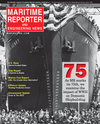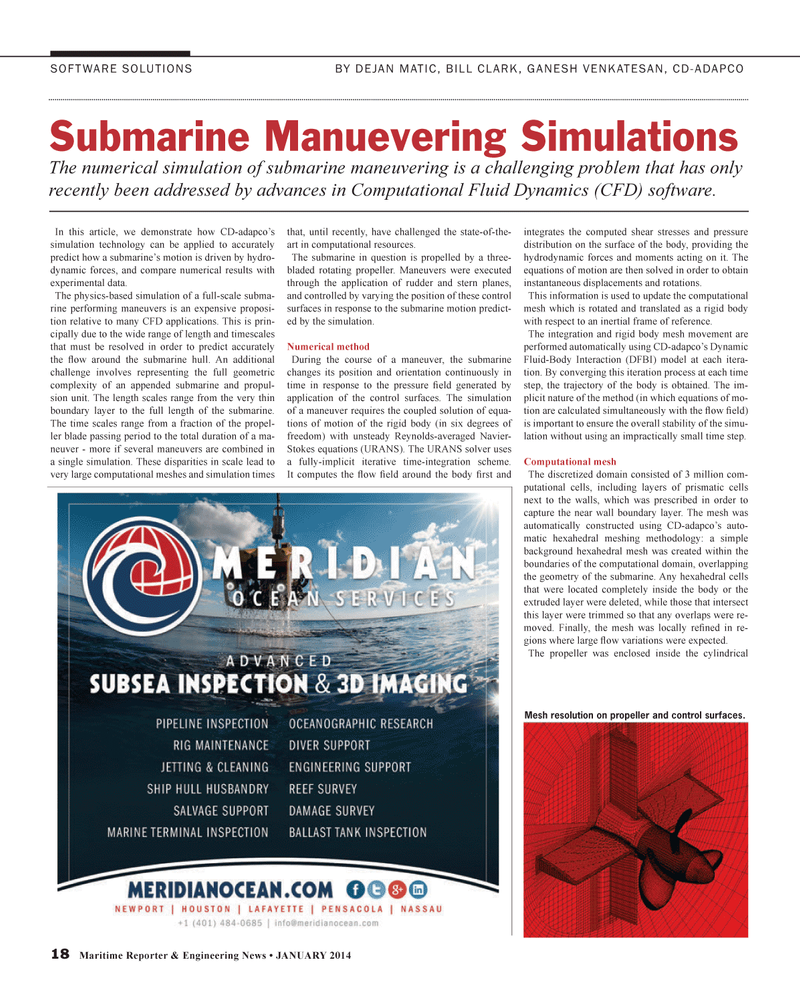
Page 18: of Maritime Reporter Magazine (January 2014)
Ship Repair & Conversion Edition
Read this page in Pdf, Flash or Html5 edition of January 2014 Maritime Reporter Magazine
18 Maritime Reporter & Engineering News • JANUARY 2014
SOFTWARE SOLUTIONS
Submarine Manuevering Simulations
The numerical simulation of submarine maneuvering is a challenging problem that has only recently been addressed by advances in Computational Fluid Dynamics (CFD) software.
In this article, we demonstrate how CD-adapco’s simulation technology can be applied to accurately predict how a submarine’s motion is driven by hydro- dynamic forces, and compare numerical results with experimental data.
The physics-based simulation of a full-scale subma- rine performing maneuvers is an expensive proposi- tion relative to many CFD applications. This is prin- cipally due to the wide range of length and timescales that must be resolved in order to predict accurately the fl ow around the submarine hull. An additional challenge involves representing the full geometric complexity of an appended submarine and propul- sion unit. The length scales range from the very thin boundary layer to the full length of the submarine.
The time scales range from a fraction of the propel- ler blade passing period to the total duration of a ma- neuver - more if several maneuvers are combined in a single simulation. These disparities in scale lead to very large computational meshes and simulation times that, until recently, have challenged the state-of-the- art in computational resources.
The submarine in question is propelled by a three- bladed rotating propeller. Maneuvers were executed through the application of rudder and stern planes, and controlled by varying the position of these control surfaces in response to the submarine motion predict- ed by the simulation.
Numerical method
During the course of a maneuver, the submarine changes its position and orientation continuously in time in response to the pressure fi eld generated by application of the control surfaces. The simulation of a maneuver requires the coupled solution of equa- tions of motion of the rigid body (in six degrees of freedom) with unsteady Reynolds-averaged Navier-
Stokes equations (URANS). The URANS solver uses a fully-implicit iterative time-integration scheme.
It computes the fl ow fi eld around the body fi rst and integrates the computed shear stresses and pressure distribution on the surface of the body, providing the hydrodynamic forces and moments acting on it. The equations of motion are then solved in order to obtain instantaneous displacements and rotations.
This information is used to update the computational mesh which is rotated and translated as a rigid body with respect to an inertial frame of reference.
The integration and rigid body mesh movement are performed automatically using CD-adapco’s Dynamic
Fluid-Body Interaction (DFBI) model at each itera- tion. By converging this iteration process at each time step, the trajectory of the body is obtained. The im- plicit nature of the method (in which equations of mo- tion are calculated simultaneously with the fl ow fi eld) is important to ensure the overall stability of the simu- lation without using an impractically small time step.
Computational mesh
The discretized domain consisted of 3 million com- putational cells, including layers of prismatic cells next to the walls, which was prescribed in order to capture the near wall boundary layer. The mesh was automatically constructed using CD-adapco’s auto- matic hexahedral meshing methodology: a simple background hexahedral mesh was created within the boundaries of the computational domain, overlapping the geometry of the submarine. Any hexahedral cells that were located completely inside the body or the extruded layer were deleted, while those that intersect this layer were trimmed so that any overlaps were re- moved. Finally, the mesh was locally refi ned in re- gions where large fl ow variations were expected.
The propeller was enclosed inside the cylindrical
BY DEJAN MATIC, BILL CLARK, GANESH VENKATESAN, CD-ADAPCO
Mesh resolution on propeller and control surfaces.
MR #1 (18-25).indd 18 1/7/2014 10:21:32 AM

 17
17

 19
19
